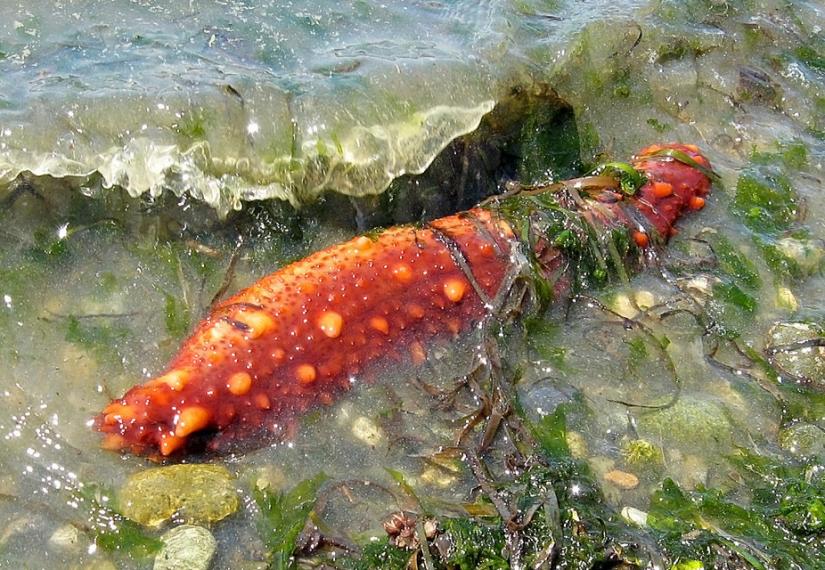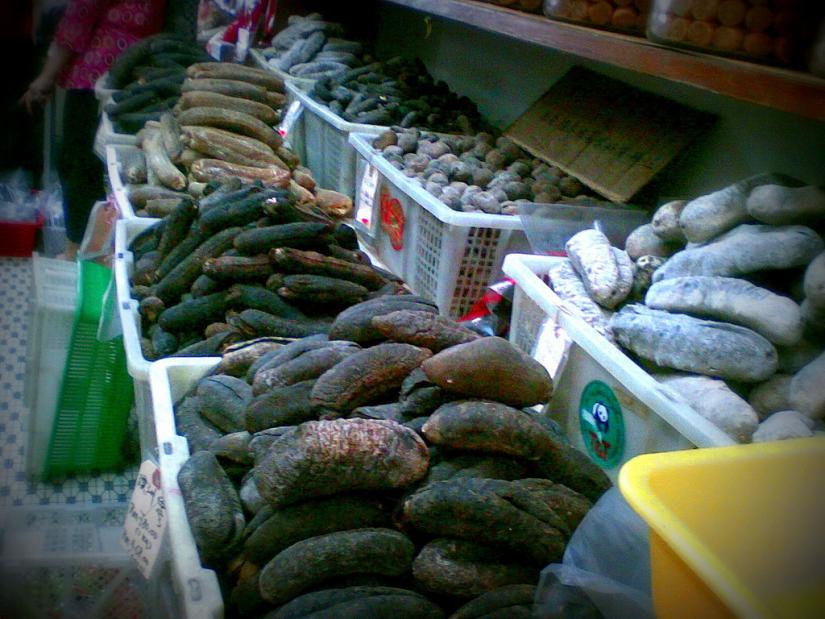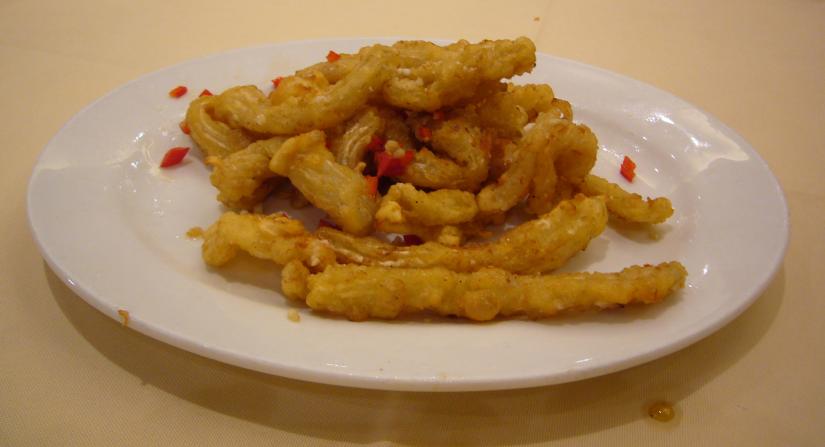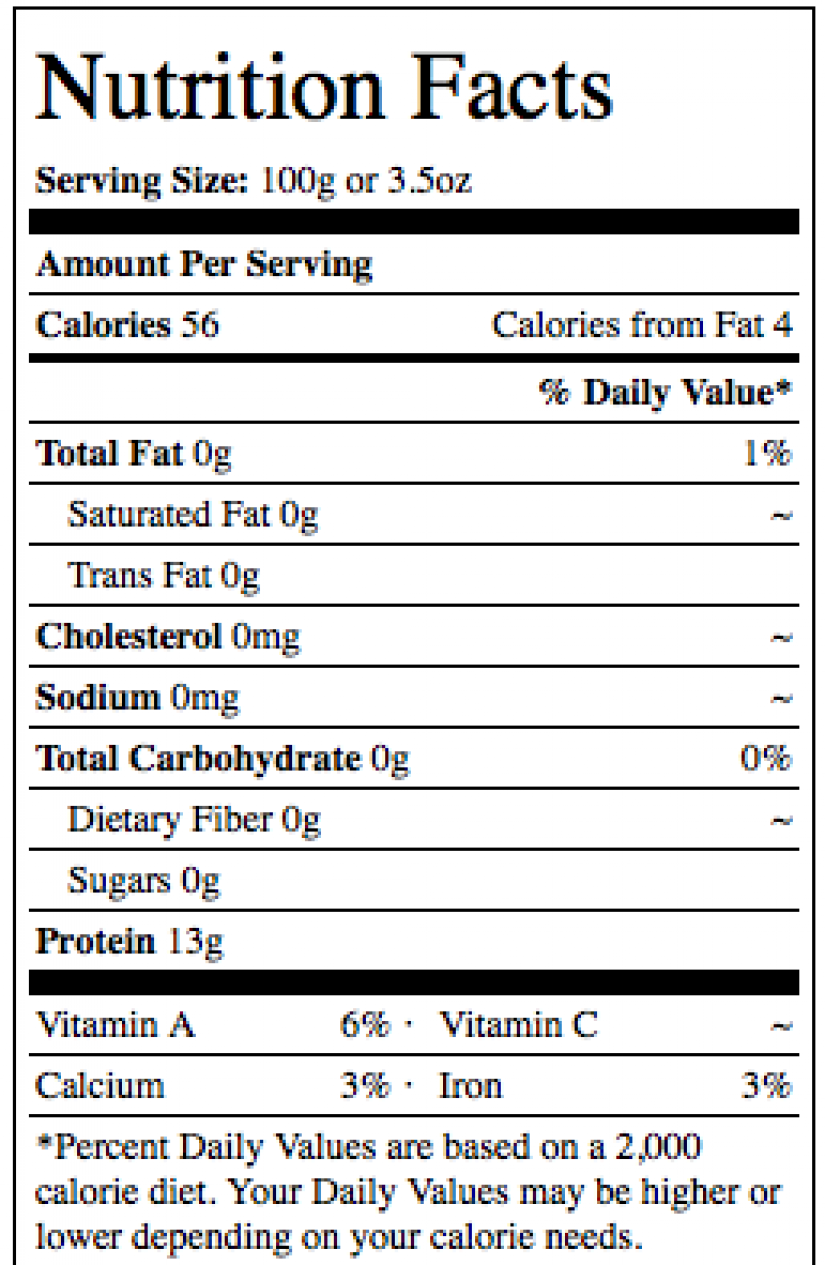California Sea Cucumber
Apostichopus californicus
The Science
THE SCIENCE
When threatened, the sea cucumber expels its guts, which later re-grow.

Taxonomic description
- Ranges in color from dark red, brown, and yellow with large, stiff papillae that is lighter in color but is usually tipped red. [3]
- Skeleton is reduced to ossicles in the body wall. [2]
- Is difficult to measure as it contracts, but a maximum length of 50 cm (~2 ft). [3]
- When relaxed, this species is the longest sea cucumber on the West Coast. [4]
Distribution
- Found from Baja California, Mexico to Alaska. [1]
Life history
- Is a broadcast spawner, and spawning is thought to coincide with phytoplankton blooms. [2]
- Becomes reproductively mature between 4 to 8 years old. [2]
- Can live up to 12 years. [1]
Habitat
- Found from low intertidal to depths of 75 meters (249 feet). [4]
- Prefers hard substrates, like rocks and shells, as well as calm water. [1,2]
- Predators include sea stars, various fish, sea otters, and crabs. [2]
- As a deposit feeder, it collects organic matter and microorganisms. [1]
The Fishery
THE FISHERY
Despite being little known, California's commercial fishery for the sea cucumber was established in 1978.

Seasonal availability
- Available year round. [6]
Regulatory and managing authority
- As established by the Marine Life Management Act, the California Fish and Game Commission regulates the fishery, and the California Department of Fish and Wildlife manages this fishery in state waters. [5]
Gear type
- Trawling is only allowed in Southern California. [1]
- Diving for sea cucumber is allowed in Northern California and Southern California. [1]
- Diving is more common than trawling, and usually occurs in conjunction with other dive fisheries, such as the sea urchin. [1]
- Special permits are required to fish for sea cucumber. [5]
Status of the fishery
- Very little is known about the population size, but is thought to be stable. [1,2]
- High natural mortality and slow growth makes this species susceptible to overfishing. [2]
- It is unknown if current fishing rate is sustainable. [2]
- Listed as least concern by IUCN due to its abundance across its entire range. [1]
- The population declined in the 1980s due to lack of regulation, but restrictions allowed for recovery. [1]
Potential ecosystem impacts
- Use of non-selective gear like trawls can damage habitat and result in bycatch, which is mediated in California by restricting trawling in sensitive habitats. [6]
- Channel Islands and Santa Barbara Islands have found a declining sea cucumber population in fished areas. [6]
The Seafood
THE SEAFOOD
The highest demand for the sea cucumber comes from the Asian market, where it is considered a delicacy.


Edible portions
- Sea cucumber an be eaten whole, or just the skin or gonads. [2]
Description of meat
- It has little to no taste, but soaks up the flavors it's cooked in. [7]
- The texture is gelatinous. [7]
Culinary uses
- Often boiled, dried, and salted before being exported, as well as frozen or pickled. [2]
- Sold fresh in California. [2]
- Typically, sea cucumber is used in Chinese soups or stews. [2]
- For a recipe for braised sea cucumbers with mushrooms, visit Pacific Sea Cucumbers Harvesters' Association. [10]
Nutritional information
- Rich in healthy levels of Vitamins A, B1, B2, B3 as well as calcium, magnesium, iron, and zinc. [8]
- Anticoagulant, anti-inflammatory, anti-hypertension, antioxidant. [8]
- Low levels of fat but high levels of protein. [8]
- Nutrition Facts for 100g of sea cucumber are found on the table. [9]
Toxicity report
- No known toxins. [8]
Seasonal availability
- Year round. [6]
References
[1] Mercier, A., Hamel, J., Toral-Granda, T., Alvarado, J., Paola Ortiz, E., Benavides, M. 2013. Parastichopus californicus. The IUCN Red List of Threatened Species 2013. Web. http://www.iucnredlist.org/details/180436/0. Accessed 2 May 2017.
[2] Bennet-Rogers, L., Ono, D. 2006. Sea Cucumbers. Pages 1-10. Status of the Fisheries Report. Web. https://nrm.dfg.ca.gov/FileHandler.ashx?DocumentID=34418&inline. Accessed 27 August 2020.
[3] Williams, K., Helmstetler, H., Cowles, D. n.d. Parastichopus californicus. Web. https://inverts.wallawalla.edu/Echinodermata/Class%20Holothuroidea/Para…. Accessed 27 August 2020.
[4] National Ocean and Atmospheric Administration. California Sea Cucumber, Parastichopis californicus. Web. https://www.afsc.noaa.gov/kodiak/photo/miscuke.htm. Accessed 2 May 2017.
[5] California Department of Fish and Wildlife. 2019. Giant Sea Cucumber, Apostichopus californicus, Enhanced Status Report. Web. https://marinespecies.wildlife.ca.gov/giant-red-sea-cucumber/management/. Accessed 27 August 2020.
[6] Bruckner, A. 2005. The recent status of sea cucumber fisheries in the continental United States of America. Web. https://www.researchgate.net/publication/238745544_The_recent_status_of…. Accessed 2 May 2017.
[7] Braised Sea Cucumbers with Chinese Vegetables. Web. http://www.food.com/recipe/braised-sea-cucumbers-with-chinese-vegetable…. Accessed 27 May 2017.
[8] Bordbar, S., Anwar, F., Saari, N. 2011. High-Value Components and Bioactives from Sea Cucumbers for Functional Foods- A Review. Web. https://www.ncbi.nlm.nih.gov/pmc/articles/PMC3210605/. Accessed 27 May 2017.
[9] Sea Cucumber. n.d. Nutritionvalue.org. Web. https://www.nutritionvalue.org/Sea_cucumber%2C_yane_%28Alaska_Native%29…. Accessed 21 September 2017.
[10] Ligia. Pacific Sea Cucumber Harvesters' Association. 2020. Braised Sea Cucumber and Japanese Mushroom with Seasonal Vegetable. Web. https://www.pscha.org/2020/06/16/braised-sea-cucumber-and-japanese-mush…. Accessed 12 January 2021.
[11] pfly. flickr. 2007. Digital image. Web. https://www.flickr.com/photos/pfly/530310813/. Accessed 12 February 2021.
[12] Stevens, B. and Edward Munk. Alaska Fisheries Science Center. n.d. Digital image. Web. https://archive.fisheries.noaa.gov/afsc/kodiak/photo/miscuke.htm. Accessed 12 February 2021.
[13] Addie. flickr. 2009. dry sea cucumber. Digital image. Web. https://www.flickr.com/photos/addie_oh_addie/3325340770/. Accessed 12 February 2021.
[14] Wang, K. flickr. 2006. Fried sea cucumber. Digital image. Web. https://www.flickr.com/photos/kentwang/132791932. Accessed 12 February 2021.



